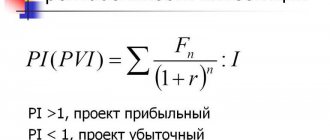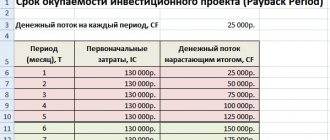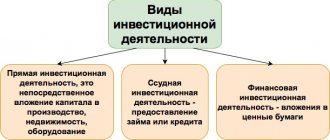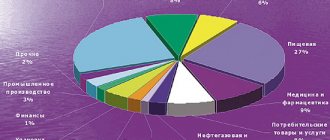Any investment is associated with risks in one way or another. Capital losses can be zero, or they can reach tens of percent. The most unfavorable outcome is the loss of the entire amount, for example, in the bankruptcy of a company whose shares were held by a private investor. To avoid getting into this situation, you need, firstly, to carefully select investment instruments, and secondly, to diversify your portfolio.
Let's look at the main ways of investing money and determine which of them have the strongest guarantees of return on investment.
Ring method
The method created by Ring provides for the reimbursement of the initial investment in equal amounts. For an accurate calculation, the formula is used:
Rk=Rd+1/N
where Rd is the rate of return on investment; N is the remaining period of economic life.
The rate of return on an investment, capital or asset is determined by the following scheme: the total cost of the investment made is divided by the remaining economic life. Modern valuation expertise uses the above method of calculating return on investment in the case when the investment is any object or real estate that is at the final stage of its economic life.
Investments are long-term investments of public or private funds used for the construction of new plants, factories, and expansion of production capacity. Investment does not include the purchase of shares and bonds, since such transactions mean the transfer of ownership of one person to another for existing capital assets.
Rice. 16.3. Consumption and savings schedules
Enterprises make investments in the following areas: ♦ construction of industrial buildings, structures, acquisition of new equipment and technologies; ♦ additional purchases of raw materials for subsequent production consumption; ♦ costs associated with increasing the productivity of workers and their qualifications, and improving working conditions. Accordingly, these areas are distinguished: ♦ investments in fixed capital; ♦ investments in inventories; ♦ investments in workforce development. Investments are divided into gross, net, autonomous, and induced. Gross investments include costs associated with the replacement of worn-out capital (depreciation) and the increase in capital investments for the expansion of production. Net investment equals gross investment minus depreciation costs of fixed capital. Net investment can have: ♦ a positive value when gross investment exceeds depreciation; ♦ zero value, when gross investment equals depreciation; ♦ a negative value when gross investment is less than depreciation. In the first case, we are talking about a growing, developing economy, in the second - about a static one, with zero growth, in the third - about a decline in production, stagnation. Autonomous investment is not associated with growth in national income. They are usually caused by innovations caused by scientific and technological progress. Such investments most often themselves become the cause of an increase in national income. There are two approaches to justifying autonomous investment - Keynesian and neoclassical. In accordance with the Keynesian approach, the introduction of autonomous investments is associated with the marginal efficiency of capital, with the determination of the results of investments not in the period in which they are made, but over a number of subsequent periods. The comparison of investment costs with the results obtained from them is carried out through discounting. The neoclassical approach connects the introduction of autonomous investments with bringing the volume of capital to optimal levels. In this case, the optimal amount of capital is the one that, with existing technology, ensures maximum profit. Induced investments are capital investments aimed at the formation of new production capacities, the reason for the creation of which is an increase in demand for material goods and services. When demand increases, additional products are produced through more intensive use of existing equipment. If increased demand is not met, then new production facilities are built to produce the missing products. To determine the volume of investment, it is necessary to know the incremental capital intensity of production, which is characterized by the required number of units of additional capital (investment) to produce an additional unit of production. It follows that for a given incremental capital intensity, induced investment is necessary. In general, investment needs appear in the form of investment demand. Investment demand represents the demand of entrepreneurs for means of production to restore worn-out capital, as well as to increase it in order to expand production. Investment demand depends on the rate of return and the bank interest rate. It follows that investment demand acts as a function of the bank interest rate (Fig. 16.4).
Rice. 16.4. Demand and investment
Investment demand increases if the rate of return on funds invested in investments is higher than the percentage of the investment of this amount of money in the bank. Investment demand falls if interest rates on loans increase and capital investment becomes less profitable. Investment demand slows down when bank interest rates rise and securities prices fall. In this case, capital resources from the sale of shares and bonds are reduced. As a result, we can conclude that when using any source of financing, it will be profitable to make investments until the interest rate exceeds the expected rate of return on the funds invested in the investment, i.e., the demand for investment is inversely proportional to the bank interest rate.
Inwood method
Inwood's model for calculating the return on initially invested capital allows you to correctly calculate the rate of return in the case when the total value of the returned funds is reinvested according to the rate of return on the invested funds.
Rk = Rd + SFF(N,Y)
where SFF is the compensation fund factor; Y = Rd - rate of return on investment.
Experts resort to this model of refund when evaluating an object or real estate that is not at the final stage of economic life, but may continue to function for some time. However, in order to return the interest rate from the invested assets, the property must meet certain requirements:
- the service life of the building must correspond to the originally stated period;
- during this period, this object must generate constant monthly income;
- upon completion of its operational life, this object or real estate is completely depreciated.
Bank deposits
The law determines that when opening a deposit, the bank undertakes to store the client’s funds and at the end of the term to return them in full along with accrued interest.
Ruble and foreign currency deposits of clients are insured by the state, but only if the bank is part of the deposit insurance system. There is a limit on the amount: no more than 1 million 700 thousand rubles per depositor. This investment protection guarantee is well established and works in Russia with almost no complaints from investors.
Conclusion: a bank deposit with its government investment guarantees is a good choice for an investor . A deposit is a liquid asset that is necessary for managing private finances. However, you should not invest all your free money in deposits, since the Russian banking system is unstable, and the offered rates barely cover inflation.
Hoskold method
Appraisal experts resort to the Hoskold method in situations where the rate of return on the initial investment is quite high and reinvestment at the same rate is unlikely. In this case, the rate of return on investment is determined by the risk-free rate.
Rk = Rd + SFF(N,Yb)
where Yb is the risk-free rate.
The main advantage of this method is the direct reflection of complete market conditions. In addition, the income statement is also taken into account.
However, this model also has disadvantages, which cannot be said about other models for calculating return on investment:
- if the investment object does not have a stable income, or the object is not yet ready, then in this case it is not possible to use this method of calculating the return on capital;
- In the absence of reliable information about market transactions, it is almost impossible to calculate the return rate using this method.
How to calculate in a simple way
The formula used to calculate the payback period in a simple way looks like this:
PAYBACK PERIOD = INVESTMENT SIZE / NET ANNUAL PROFIT
Or
PP = K0 / PChsg
We take into account that PP is the payback period expressed in years.
K0 - the amount of invested funds.
PChsg - Net profit on average for the year.
Example.
You are offered to invest an amount of 150 thousand rubles in the project. And they say that the project will bring in an average of 50 thousand rubles a year in net profit.
Using simple calculations, we obtain a payback period of three years (we divided 150,000 by 50,000).
But such an example gives out information without taking into account that the project can not only generate income during these three years, but also require additional investments. Therefore, it is better to use the second formula, where we need to obtain the value of IFsg. And it can be calculated by subtracting the average expense for the year from the average income. Let's look at this using the second example.
Example 2:
Let us add the following fact to the existing conditions. During the implementation of the project, about 20 thousand rubles will be spent every year on all kinds of expenses. That is, we can already obtain the value of PChsg - by subtracting 20 thousand rubles (expenses for the year) from 50 thousand rubles (net profit for the year).
So, our formula will look like this:
PP (payback period) = 150,000 (investment) / 30 (average annual net profit). Result - 5 years.
An example is illustrative. After all, as soon as we took into account the average annual costs, we saw that the payback period increased by as much as two years (and this is much closer to reality).
This calculation is relevant if you have the same income for all periods. But in life, the amount of income almost always changes from one year to the next. And to take this fact into account, you need to perform several steps:
We find the whole number of years it will take for the final income to be as close as possible to the amount of funds spent on the project (invested).
We find the amount of investments that remained uncovered by profit (we take it as a fact that income arrives evenly throughout the year).
We find the number of months it will take to reach full payback.
Let's consider this option further.
Example 3.
The conditions are similar. You need to invest 150 thousand rubles in the project. It is planned that during the first year the income will be 30 thousand rubles. During the second - 50 thousand. During the third - 40 thousand rubles. And in the fourth - 60 thousand.
We calculate income for three years - 30+50+40 = 120 thousand rubles.
In 4 years the amount of profit will be 180 thousand rubles.
And considering that we invested 150 thousand, it is clear that the payback period will occur somewhere between the third and fourth year of the project. But we need details.
Therefore, we proceed to the second stage. We need to find that part of the invested funds that remained uncovered after the third year:
150,000 (investments) - 120,000 (income for 3 years) = 30,000 rubles.
Let's move on to the third stage. We will need to find the fractional part for the fourth year. There are 30 thousand left to cover, and the income for this year will be 60 thousand. So we divide 30,000 by 60,000 and get 0.5 (in years).
It turns out that taking into account the uneven influx of money across periods (but uniform across months within a period), our invested 150 thousand rubles will pay off in three and a half years (3 + 0.5 = 3.5).
Advantages of using the described methods
Correct and accurate calculation of internal revenues allows you to find out whether capital investments will be effective in each individual case. Calculating the internal rate of return and comparing it with the agreed rules for investing in capital allows you to find out whether the project will be justified. If the internal income from the object exceeds the stated capital standards, then in this situation the rate of return on investment is justified. The entire project is considered successful, and the percentage of the object falling or ruining becomes minimal.
Why calculate return on investment?
So, profitability or return is necessary to determine the effectiveness of investments. The return on investment rate itself - ROI - is a universal way to find out:
- to what extent the improvement or expansion of the business is justified;
- is it worth investing in a particular project or startup;
- How effectively does advertising work?
- does it make sense to purchase securities of a particular company;
- is it worth purchasing shares in a certain mutual fund, and so on.
In other words, it helps you understand whether a particular operation is needed or not needed in your investment.
At the same time, to calculate ROI, information provided in the public domain is used, there is no hidden meaning or subtext; sometimes it is enough to look at the company’s statistics and reporting.
Data required for calculations
If, according to your calculations, the ROI is more than 100%, then your tool is effective; if it is less than 100, then, accordingly, it is not effective. In this case, a number of data are usually used for calculations:
- product cost;
- income from the sale of one unit of product;
- the full amount of investment;
- the price of the asset at the time of acquisition and sale.
If we are talking about an investment audit, then the calculation of return is especially important here, since it allows us to choose the most effective one for investment among many objects, even similar in terms of indicators. And even if according to company reports everything is fine, a more detailed analysis may show that the situation is exactly the opposite.
In turn, having calculated the ROI, you can adjust the strategy, further acquire those assets that have a high level of return, that is, strengthen positions, or tighten or close weak positions.
Analysis example
The company uses equipment to produce products. This year, equipment appeared with the same functions, but it is more productive, mobile and fast. The acquisition of equipment will increase the volume of production and reduce manufacturing costs. The initial cost of the equipment was 32 thousand dollars. It was subject to depreciation over 10 years. The current cost of the equipment is $15 thousand. New equipment costs $55,500. Its service life is 8 years. After this time has expired, the equipment will be turned into scrap. The cost of this scrap will be $1,500.
The productivity of current equipment is 200 thousand units of finished products per year. When using new equipment, the considered value will increase by 25%. The organization's management is confident that this entire volume of products will be sold. Current costs per unit of product:
- 12 cents – payment of salaries.
- 50 cents – raw material costs.
- 24 cents is overhead.
When operating new equipment, expenses will be as follows:
- 8 cents – payment of salaries.
- 47 cents – raw material costs.
- 16 cents - overhead.
Spending on wages decreased due to the fact that the operation of new equipment made it possible to fire one operator. The process has become more automated. Costs for raw materials are reduced due to the fact that losses are reduced. A table is compiled based on these values. In this case, the initial investment is $35,625 (minus income from the sale of old equipment and tax deductions).
ROI: return on investment
The formula used to calculate ROI reflects the return on investment. The abbreviation itself, when deciphered and translated from English, means “return on investment.” This indicator is indispensable for calculating payback. The profitability of a specific project is calculated using one of the universal formulas. To take into account errors, you will have to pay attention to the features of a particular project.
Universal calculation formula:
ROI = (profit - project cost) / amount invested * 100%.
The resulting value will be the main component of the analysis for a potential investment. The more profitable the opportunity, the better the ROI formula will show. A positive value indicates that the company is operating at a profit.
By the way, in practice, the use of the coefficient is widespread not only among analysts and experts in the financial sector, but also in government agencies and companies involved in loans. Owning a certain business, you can apply the methodology to estimate the possible profit of the project. The only difference is in the basis: instead of the amount invested as a percentage, the authorized capital is taken.
Scheduled return
When contacting a company, a potential investor usually sees the following offer: “We will provide you with up to 60% return.” This means that on average the investment made in this firm had this rate of return. But there are no guarantees that your money will work out at such a percentage. Much is determined by risk, as well as by industry - for some the indicators are greater, for others - less.
For example, when analyzing startups in the field of information technology, we can conclude that out of a dozen, 2-3 projects will fail. That is, the investor must realize that he has about a 70% chance of losing money. In addition to getting a return on your investment, it would be nice to get some profit. There is a special indicator - required rate of return (“required level of profitability”). It is desirable that it be several hundred percent.
How to decide to invest?
How to enter an investment project? An example of an ordinary spontaneous purchase is familiar to us all - these are the so-called mood purchases. But when it comes to something big, the mechanisms that push people to complete a transaction are completely different. Potential investors are most responsible when it comes to investing in equipment, machinery, and tools that can be used in their enterprise in the future. No wonder: everyone wants reliability, confidence in the future and minimizing costs.
ROI is the best way to measure your return on investment and determine whether a business is worth the time and money. If you have doubts about a particular project and are considering investing in it, you can turn to third-party experts when your own calculations seem inconclusive.
What is investment analysis
Investment analysis (IA) is a set of activities necessary to formulate an effective business plan and establish the degree of feasibility of investment. The analysis allows you to justify the chosen investment method.
What are the risks of an investment project ?
When should the analysis be carried out?
Investment analysis can be divided into two categories:
- Subject analysis. Research is carried out before the transaction begins. It is fundamental for deciding whether to invest. The process involves analyzing all aspects that may affect the course of investment. Subject analysis involves the formation of investment goals and objectives. The degree of risk is calculated. The social significance of the project and the strategy for its management are determined.
- Temporal analysis. It is carried out throughout the entire investment project.
IMPORTANT! Investment analysis is a non-short-term measure, but a dynamic activity. Carrying it out during the project implementation allows you to adjust tasks and goals and increase efficiency.
How do the terms of a construction investment agreement affect its qualification by the court and what should you pay attention to when drawing it up ?
Investment analysis functions
Let's consider the functions of investment analysis:
- Formation of a structure for collecting information necessary for effective investment.
- Identification of risks that are possible at various stages of an investment project.
- Finding alternative ways to invest.
- Creating a basis for decision making.
- Establishing the priority of investment activities.
- Creating a basis for making decisions regarding fundraising.
IA is a multifunctional tool.
Objectives of investment analysis
Let's consider the tasks of IA:
- Selection of funding sources that will provide the expected result.
- Selecting appropriate investment decisions that will enhance the company's competitiveness.
- Analysis of the degree of risk for investors.
- Determining the degree of profitability of the project.
- Improving the quality of investments.
Investment analysis allows you to create a base for all stages of an investment project.
IMPORTANT! The main purpose of the analysis is to determine the feasibility and effectiveness of the project. The result of its implementation and the benefits of the project are calculated. If the benefits from the investment are insufficient, the project will not be approved.
Analysis procedure
The following stages of investment analysis can be distinguished:
- Formation of an information basis. Information is collected on the basis of which the analysis will be performed.
- Conducting preliminary research. In particular, a preliminary analysis of external factors and conditions of the investment environment is carried out.
- Assessment of external factors. At this stage, the market itself and external parameters that may influence investment attractiveness are examined.
- Study of the volume of available funds in the company. This is necessary in order to determine the amount of money that will be used for investment. This stage also explores the potential of the organization.
- Economic Stability Study.
- Creating a conclusion about an investment project based on a set of factors.
- Conducting comparative analysis.
The stages of analysis may vary depending on the purpose of the study.











